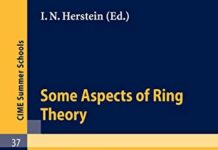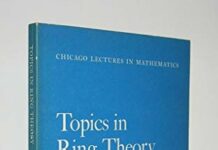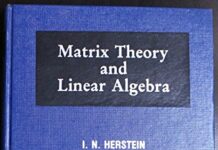
Ebook Info
- Published: 2018
- Number of pages: 709 pages
- Format: PDF
- File Size: 17.16 MB
- Authors: I.N Herstein
Description
BEST TOP USEFUL BOOK FOR THE FOLLOWING EXAMS AND INTERVIEWS AND RESEARCH* ALL INTERNATIONAL EDUCATION RESEARCH AND EXAMS* ALL UG & PG & PHD & PDF * IIT JEE* IIT JAM* GATE* CIVILS SERVICES* SET – STATE ELIGIBILITY TEST* NET – NATIONAL ELIGIBILITY TEST* ALL INDIAN UNIVERSITY EXAMS* CENTRAL UNIVERSITY EXAMS* IISC ENTRANCE EXAMS* INSPIRE FELLOWSHIP* ALL FELLOWSHIP NATIONAL LEVEL EXAMS* POST DOCTORAL EXAMS* ALL INDIAN UNIVERSITY ENTRANCE EXAMS* ASSISTANT PROFESSOR EXAMS* JUNIOR LECTURER EXAMS* RESEARCH ORIENTED* SUBJECT ANALYSIS* SUBJECT THESISPreface to the Second Edition I approached rev1smg Topics in Algebra with a certain amount of trepidation. On the whole, I was satisfied with the first edition and did not want to tamper with it. However, there were certain changes I felt should be made, changes which would not affect the general style or content, but which would make the book a little more complete. I hope that I have achieved this objective in the present version. For the most part, the major changes take place in the chapt¥r on group theory. When the first edition was written it was fairly un-common for a student learning abstract algebra to have had any previous exposure to linear algebra. Nowadays quite the opposite is true; many students, perhaps even a majority, have learned something about 2 x 2 matrices at this stage. Thus I felt free here to draw on 2 x 2 matrices for examples and problems. These parts, which depend on some knowledge of linear algebra, are indicated with a #. In the chapter on groups I have largely expanded one section, that on Sylow’s theorem, and added two others, one on direct products and one on the structure of finite abelian groups. In the previous treatment of Sylow’s theorem, only the existence of a Sylow subgroup was shown. This was done following the proof of Wielandt. The conjugacy of the Sylow subgroups and their number were developed in a series of exercises, but not in the text proper. Now all the parts of Sylow’s theorem are done in the text materi9-l. In addition to the proof previously given for the existence, two other proofs of existence are carried out. One could accuse me of overkill at this point, probably rightfully so. The fact of the matter is that Sylow’s theorem is important, that each proof illustrates a different aspect of group theory and, above all, that I love Sylow’s theorem. The proof of the con-jugacy and number of Sylow subgroups exploits double cosets. A by-product of this development is that a means is given for finding Sylow subgroups in a large set of symmetric groups. For some mysterious reason known only to myself, I had omitted direct products in the first edition. Why is beyond me. The material is easy, straightforward, and important. This lacuna is now filled in the section treating direct products. With this in hand, I go on in the next section to prove the decomposition of a finite abelian group as a direct product of cyclic groups and also prove the uniqueness of the invariants associated with this decomposition. In point of fact, this decomposition was already in the first edition, at the end of the chapter on vector spaces, as a consequence of the structure of finitely generated modules over Euclidean rings. However, the case of a finite group is of great importance by itself; the section on finite abelian groups underlines this importance. Its presence in the chapter on groups, an early chapter, makes it more likely that it will be taught. One other entire section has been added at the end of the chapter on field theory.
User’s Reviews
Reviews from Amazon users which were colected at the time this book was published on the website:
⭐This is my first encounter with a proof based course and this book did have plenty of examples for proving some of the more simple results. A typical strategy was to use the same examples from section to section and expanding them as the student is introduced to more definitions and theorems. For the integers mod n is first introduced in Chapter 1 in the number theory review section and is later expanded on in Chapter 2 for groups and subgroups and equivalence classes and all kinds of stuff. On the one hand it is helpful to see the connections that exist between all these different theorems and definitions, but it would be nice to see more and different examples. This subject is very difficult in my opinion, most problems involve a proof of one form or another, the book does do a good job in tackling the subject for a more experienced math undergrad.
⭐Herstein was an unmatched Abstract Math professor, it is amazing his questions are so well designed, where did he get so many well-thought exercises ? they are the best means to digest the concepts in his texts, succint though but very rich in substance. This is only possible if the author has a very profound grasp of the subject.This book is not the latest edition. Some solution books have more questions not in this book. Where to get the most updated edition ?
⭐This book clinches for me a caveat to live by in my future mathematical career: Never undertake to learn any new subject in mathematics from a text that is described as “chatty” or “informal”. Herstein’s prose is mildly amusing up until page 3, whereafter it becomes a nuisance and later a downright irritant. And that’s the least of this book’s problems.We start with the first sentence: “For many readers this book will be their first contact with abstract mathematics.” That straightaway blows away any excuse Herstein might muster to save face in light of the content on subsequent pages.First, each section usually has exercises divided into three categories: “Easier”, “Middle-level”, and “Harder”. The easier problems range from mundane pencil-pushing to rather stiff analyses; the mid-level problems are typically quite difficult or nearly impossible; and the harder problems are almost universally intractable – mainly because they have little bearing on what the author discusses. To wit: any problem will be “hard” if you give your student absolutely nothing to go on. To entice a reader to try out a harder problem, the competent instructor knows to leave a few bread crumbs that lure the reader into the forest. Herstein does not do this. Harder problems are routinely bolts from the blue presented in vacuo, mere non sequiturs in the eyes of the struggling newbie. We need not discuss the so-called “Very Hard Problems” some sections feature, as the mathematical community is still researching them in a feverish competition that surely will bag someone a Fields Medal.The beginner (the book’s alleged target audience) will find section 2.2 utterly demoralizing. The exercises are not categorized as described above, and guess what? They’re ALL “harder problems”, most of which I still can’t solve to this day – and I’ve moved on successfully to graduate-level abstract algebra. And guess what the title of the section is? “Some Simple Remarks”. Herstein is either arrogant beyond the ken of mortal men, or the most sadistic professor to come down the pike since the days of Attila the Hun. By page 50 the book is sending you a clear message: “You are an abject idiot. A gibbering nincompoop. Why are you still even trying?”Some crucial definitions are couched in the thick of exercise sets where they do not belong. You know, little things like the definition of a cyclic group.Crucial results used to prove pivotal theorems are sometimes poached from exercises from earlier sections, so the book, damningly, is NOT self-contained. It is inexcusable to have the proof of Cauchy’s theorem, for example, hinge on asinine parenthetical statements like “see Problem 31 of Section 4” or “See Problem 16 of Section 3, which you should be able to handle more easily now.” What the hell is that about? I’ve NEVER seen a math text do this at the introductory level. It’s gross academic negligence of the highest order. The rule is this: exercises build on definitions and theorems, NOT the other way around!It’s fair to sometimes ask the reader to provide the proof of a lemma, corollary, or minor theorem in an exercise. What is decidedly NOT helpful in the least is scattering the proof of a major theorem all over the map, with some scraps coming before the theorem and remaining scraps coming after. One of Herstein’s favorite stunts: a sort of heuristic “hand-waving” argument that weaves around like the Mississippi river, culminating with a statement along the lines of “We have now proved the following theorem…”. It’s okay to do that once in awhile to break the monotony, but NOT two-thirds of the time in a pathetic attempt to seem less formal and be the student’s “buddy”. Students of algebra do not need a buddy, they need a teacher who knows how to present material nonrandomly.The reader almost has to hire a private investigator just to sort out the precise definition of congruence modulo n. What does “a = b mod n” mean? Why, “a ~ b”, of course. But what does “a ~ b” mean? Merely that “n | (a – b)”, silly goose. Ah, so what does “n | (a – b)” mean? For something so important as the concept of congruence modulo n, one would think its definition would be enshrined right under the bold heading “Definition”. But no: it’s buried deep in an inane example.Other times Herstein has it in for private investigators, and right smack in the middle of a theorem readers are reminded that “Ker phi” means “the kernel of phi”. Wow, thanks! The only viable explanation for this behavior is that Herstein is violently allergic to theorems that are expressed in only one line; so, he’ll pack them with irrelevant crap to ensure they’re at least two lines long.Then there are the tragic expressions of the various correspondence theorems that each utterly fail to mention the relevant correspondence. One concludes with the statement “This sets up a 1-1 correspondence between all the ideals of R’ and those ideals of R that contain K.” The understandably befuddled novitiate is led to ask: “Well isn’t that special. So…what is it?” Herstein seems incapable of placing himself in the shoes of beginners and seeing that what’s obvious to him can be a mystery to someone else. An appropriate function must be defined, then demonstrated to be bijective. By no means trivial! Then two pages later 2-by-2 matrices are kicked around like the reader is a drooling imbecile who’s never seen them before.A lot of “examples” are actually fake fronts for exercises, so don’t let their apparent abundance bedazzle you overmuch. Others are laughably trivial or ludicrously irrelevant.Finally, it’s breathtaking that Herstein can have an entire section titled “Cycle Decomposition” without ever defining what it means. Just another example of lousy organization and a ham-fisted presentation that never survives the rough-draft version of worthier texts.
⭐I need to review my Abstract Algebra for some PhD prelim exams. Originally, I did most of my learning from Durbin (garbage book) and Beachy and Blair (great intro, but bloated if you don’t need hand-holding through all the examples.)This text is far smaller, so carrying it around isn’t a bother. There are HEAPS of exercises that vary in difficulty. Working these exercises is where the learning/understanding really happens!I highly recommend this for anyone interested in studying higher level mathematics!
⭐A small book but bursting with ideas..the frequent use of conversational type approach to bring into view concepts and the problems related to their comprehension is very effective for the reader trying to learn these ideas de novo..the problem sets are the heart of the book and do force the reader to think ” mathematically”
⭐Importante para el estudio de Física TeóricaA bit succint in areas of the book, but good overall. I like the style of the author’s writing – it is quite humorous! Recommended.
⭐Clear presentation of mathematics, including proofs and intuitive explanations
Keywords
Free Download Abstract Algebra: Third Edition in PDF format
Abstract Algebra: Third Edition PDF Free Download
Download Abstract Algebra: Third Edition 2018 PDF Free
Abstract Algebra: Third Edition 2018 PDF Free Download
Download Abstract Algebra: Third Edition PDF
Free Download Ebook Abstract Algebra: Third Edition


